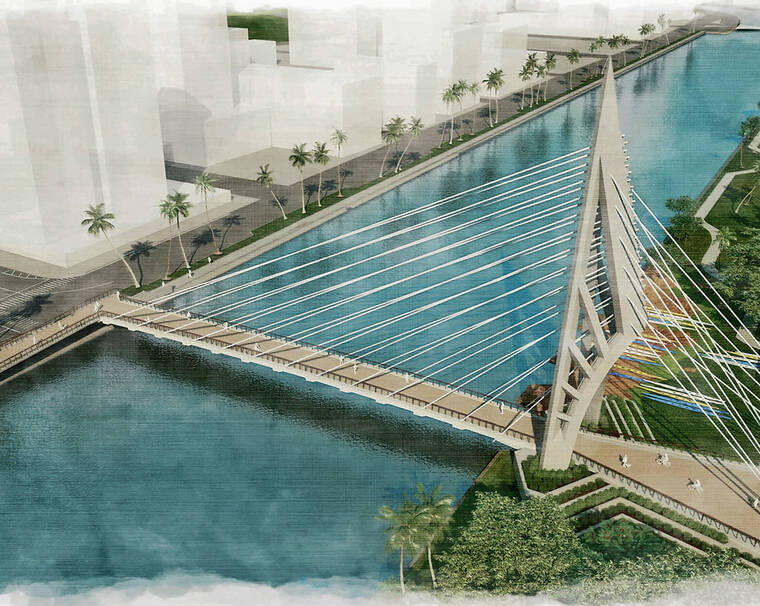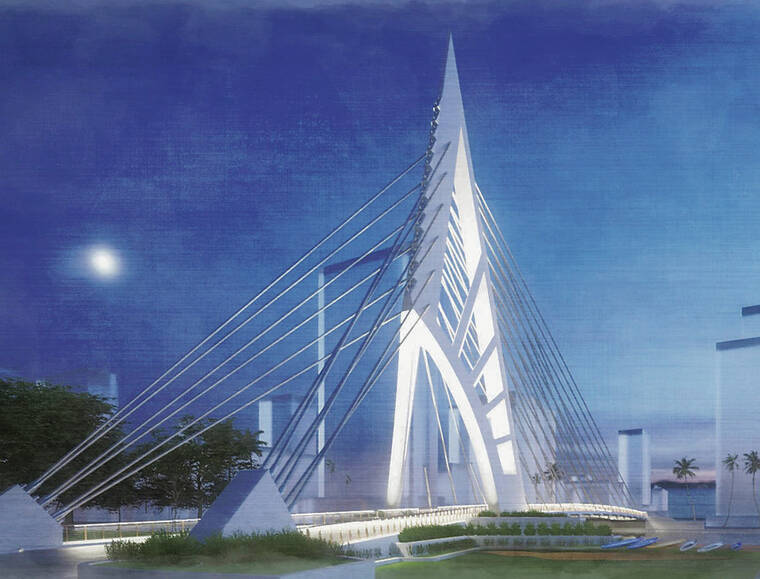City awarded $25M toward Ala Wai pedestrian bridge

COURTESY RENDERING
The proposed bridge will be known as Ala Pono and serve as a gateway to the northern boundary of Waikiki.

COURTESY RENDERING
The building of the Ala Wai bridge is planned for next summer.


The Honolulu Department of Transportation Services has been awarded $25 million in federal funding toward construction of the planned Ala Wai pedestrian bridge, the city announced Thursday.
DTS said the funding commitment — originating from the U.S. Department of Transportation’s RAISE discretionary grant program, which aids in the building of local infrastructure projects — means the planned bridge, also known as Ala Pono, can move forward for what the city deems is a key pedestrian and bicycle link for the McCully, Moiliili and Waikiki neighborhoods.
The Ala Pono bridge is estimated to cost over $63.3 million to design and construct, according to DTS spokesperson Travis Ota.
“The project is programmed using 80% federal funds and 20% local funds for each phase,” Ota told the Honolulu Star-Advertiser via email.
The city has been applying for RAISE grant funding since 2021, he added.
Ala Pono is envisioned as a mauka-makai span that will cross the 1.3-mile-long Ala Wai Canal. The canal and its embankment, bordering sidewalks, benches, paths and greenways are a recreational resource for neighboring communities, while the canal itself serves as the northern boundary of Waikiki.
Don't miss out on what's happening!
Stay in touch with breaking news, as it happens, conveniently in your email inbox. It's FREE!
The deck of the bridge will be 14 feet above the canal level, allowing outrigger canoe paddling and other water recreational activities to continue, and higher than a contemplated flood mitigation wall.
On the Waikiki side, a ramp would be built between the proposed flood wall and the Ala Wai Boulevard sidewalk. The bridge will not interfere with the planned flood wall, the city says.
As designed, the span is meant only for “biking, walking or rolling,” the city says, and will not accommodate motorized vehicles, particularly cars or trucks.
“The purpose of the project is to provide safe access for people traveling by foot or by bicycle across the Ala Wai Canal between Ala Wai Boulevard and the Manoa/Palolo Stream,” Ota said.
To that end, the city says the bridge will reduce vehicle carbon emissions by promoting active transportation in the form of walking and biking that might involve short trips throughout neighborhoods adjacent to Waikiki.
And with a nearly 300-foot clear span, the concrete cable-stayed bridge will keep sight lines for canoeing and other traditional practices and not interfere with the historic canal walls, the city says.
Other features of the bridge include its asymmetrical design, meant to be an abstraction of local inspirations such as fishing nets, waterfalls and traditional musical instruments, according to the city. The single-tower design also will help maintain views of the surrounding urban landscape.
The project included a draft environmental assessment public review period, and the city says it will continue to work with stakeholders on the environmental assessment and the National Historic Preservation Act to create a final site plan and bridge design.
Ota said the project’s environmental clearance is expected to be completed this winter, while the design-build portion of the project will begin next summer.




